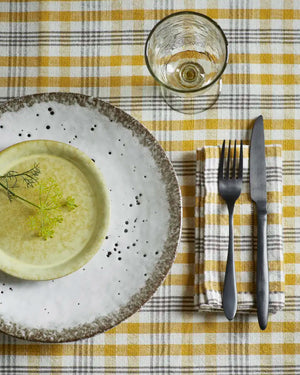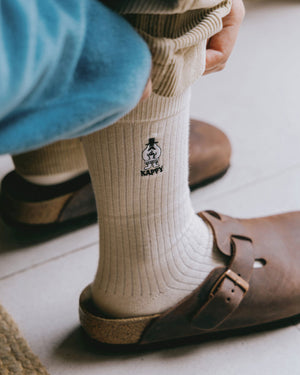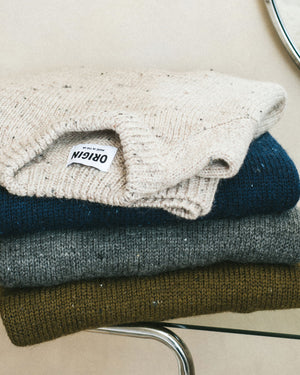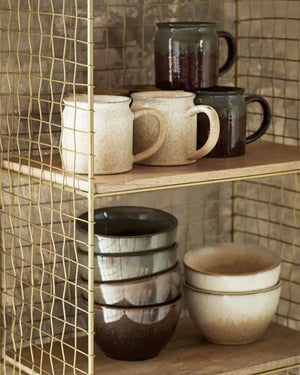 Danish brand SELECTED has been stocked at AIDA since our doors opened in 2012. Selling worldwide under the BESTSELLER clothing company, SELECTED is one of our most successful brands and the largest company we buy from. A talk at SELECTED’s London Office enlightened us to the progress the company has been making regarding sustainability. Integral to SELECTED’s sustainable progress were conferences they organised in China, India and Turkey in 2017 with their global suppliers. The aim was simple: to bring fashion forward and embed sustainability into SELECTED’s production and design. Championing sharing knowledge and collective effort, their innovative and honest approach resonates with real change in the industry. Inspired by the changes already in play, we were eager to learn more. Luckily for us, Poul Bendixen, SELECTED’s Brand Buying Manager, joined us in store for a cup of coffee and a deep dive into all the topics we thought you, our customer, would want to know about. On Defining Sustainability At SELECTED
Danish brand SELECTED has been stocked at AIDA since our doors opened in 2012. Selling worldwide under the BESTSELLER clothing company, SELECTED is one of our most successful brands and the largest company we buy from. A talk at SELECTED’s London Office enlightened us to the progress the company has been making regarding sustainability. Integral to SELECTED’s sustainable progress were conferences they organised in China, India and Turkey in 2017 with their global suppliers. The aim was simple: to bring fashion forward and embed sustainability into SELECTED’s production and design. Championing sharing knowledge and collective effort, their innovative and honest approach resonates with real change in the industry. Inspired by the changes already in play, we were eager to learn more. Luckily for us, Poul Bendixen, SELECTED’s Brand Buying Manager, joined us in store for a cup of coffee and a deep dive into all the topics we thought you, our customer, would want to know about. On Defining Sustainability At SELECTED  We want to create something that is of high quality, which our customers are proud to wear, whilst staying true to SELECTED’s identity. It’s about sustainability and it’s about growing. It’s about growing our business and we do that by growing our people - nothing will happen if the individual isn’t becoming better every day. It all comes back to the point of why we met up in China, India and Turkey with our global suppliers - 70 people in one room at each event, sharing knowledge, where all questions asked are answered. And a continuum made afterwards to say OK, these are the facts and figures, and these are the contacts that you can use to make things happen. It’s simple - sort of! If we don’t know something ourselves then we reach out to organisations, companies, other people who know more than we do and that’s the way to learn. On Measuring Sustainability At SELECTED
We want to create something that is of high quality, which our customers are proud to wear, whilst staying true to SELECTED’s identity. It’s about sustainability and it’s about growing. It’s about growing our business and we do that by growing our people - nothing will happen if the individual isn’t becoming better every day. It all comes back to the point of why we met up in China, India and Turkey with our global suppliers - 70 people in one room at each event, sharing knowledge, where all questions asked are answered. And a continuum made afterwards to say OK, these are the facts and figures, and these are the contacts that you can use to make things happen. It’s simple - sort of! If we don’t know something ourselves then we reach out to organisations, companies, other people who know more than we do and that’s the way to learn. On Measuring Sustainability At SELECTED  For a product to be identified as sustainable, at least 50% of the item has to consist of more sustainable materials such as organic cotton and recycled materials, including a break-down of the composition and a description of the materials used. Take a knitted jumper made from wool, polyester and acrylic; if the composition is 30% responsible wool, 22% recycled polyester and 48% acrylic, we would be able to call this “more sustainable”. On Animal Fibres
For a product to be identified as sustainable, at least 50% of the item has to consist of more sustainable materials such as organic cotton and recycled materials, including a break-down of the composition and a description of the materials used. Take a knitted jumper made from wool, polyester and acrylic; if the composition is 30% responsible wool, 22% recycled polyester and 48% acrylic, we would be able to call this “more sustainable”. On Animal Fibres  Animal welfare remains a very important topic for us. Wool is a fantastic fibre, keeping you warm like no other - 23% of SELECTED products have wool content, if we couldn’t use wool we would be challenged. Our policy is that no animal is harmed during the manufacturing of our products, and our animal welfare policy outlines our position on using materials derived from animals, including no wool from sheep that have been raised using the mulesing practice. We’re a fur-free company and we no longer use silk, replacing it with a range of TENCEL™ which gives a similar feel. On Waste And Chemical Produce
Animal welfare remains a very important topic for us. Wool is a fantastic fibre, keeping you warm like no other - 23% of SELECTED products have wool content, if we couldn’t use wool we would be challenged. Our policy is that no animal is harmed during the manufacturing of our products, and our animal welfare policy outlines our position on using materials derived from animals, including no wool from sheep that have been raised using the mulesing practice. We’re a fur-free company and we no longer use silk, replacing it with a range of TENCEL™ which gives a similar feel. On Waste And Chemical Produce  The biggest t-shirt factory we are manufacturing at just outside of Dakha is a village of about 13,000. They spin their own yarn, dye it, then knit the fabric themselves. The whole process in one place. The water that they have used for dying is run through a filtering system, separating water and sludge. After filtering, the water is so clean it’s drinkable. The sludge from not harmful chemicals and dyes collects in tanks and is made into bricks to build houses. It is a perfect example of the reuse of a waste material. On Renewable Energy
The biggest t-shirt factory we are manufacturing at just outside of Dakha is a village of about 13,000. They spin their own yarn, dye it, then knit the fabric themselves. The whole process in one place. The water that they have used for dying is run through a filtering system, separating water and sludge. After filtering, the water is so clean it’s drinkable. The sludge from not harmful chemicals and dyes collects in tanks and is made into bricks to build houses. It is a perfect example of the reuse of a waste material. On Renewable Energy  We want to transform the fashion industry into a sustainable one. Our new sustainability strategy has specific goals in energy consumption and renewable energy. By 2021 we’re aiming for all our owned and operated buildings globally to be powered 100% by renewable energy. Our ultimate climate strategy is to move Fashion FWD until we are climate positive. On Working with Our Suppliers
We want to transform the fashion industry into a sustainable one. Our new sustainability strategy has specific goals in energy consumption and renewable energy. By 2021 we’re aiming for all our owned and operated buildings globally to be powered 100% by renewable energy. Our ultimate climate strategy is to move Fashion FWD until we are climate positive. On Working with Our Suppliers  We are strict on the facilities and security in factories. As part of our supplier and factory on-boarding programme, factories must first be assessed and evaluated with our minimum standards before they are accepted to work with us. Both our own teams and third-party auditors visit the factories regularly to monitor social and environmental performance, giving recommendations for improvements. We really value partnership and care about those we work with. One of the factories in Bangladesh has 8 full time doctors employed for the workers. They have a kindergarten, a canteen with healthy food and programmes to teach the female workers about hygiene, nutrition and the economy. We believe that by helping a country develop, we help the people thrive as well. On Small Steps We Can All Take
We are strict on the facilities and security in factories. As part of our supplier and factory on-boarding programme, factories must first be assessed and evaluated with our minimum standards before they are accepted to work with us. Both our own teams and third-party auditors visit the factories regularly to monitor social and environmental performance, giving recommendations for improvements. We really value partnership and care about those we work with. One of the factories in Bangladesh has 8 full time doctors employed for the workers. They have a kindergarten, a canteen with healthy food and programmes to teach the female workers about hygiene, nutrition and the economy. We believe that by helping a country develop, we help the people thrive as well. On Small Steps We Can All Take  We can start by choosing to buy ‘responsibly crafted’ products. Wear the garment a few times before washing; and when you do, wash it on 30 degrees and on a short programme. It has been measured that the biggest impact on the environment related to garments comes from our own laundering. Also, buy something you like, keep it for a long time, and take care of your garments so they last. When you decide you no longer want the garment, pass it on to someone to enjoy instead of throwing it away. It’s on all of our shoulders: us as brands, our colleagues in stores, and those that have online stores, to educate our consumers to make better choices. Don’t be afraid of not being perfect because I know we are not perfect! Being afraid of not being perfect is sometimes the biggest obstacle. Just reach out and do something. Shop Responsibly Crafted Women's Here. Shop Responsibly Crafted Men's Here. To find out more about BESTSELLER’s Fashion FWD strategy, go here. All images from Bestseller
We can start by choosing to buy ‘responsibly crafted’ products. Wear the garment a few times before washing; and when you do, wash it on 30 degrees and on a short programme. It has been measured that the biggest impact on the environment related to garments comes from our own laundering. Also, buy something you like, keep it for a long time, and take care of your garments so they last. When you decide you no longer want the garment, pass it on to someone to enjoy instead of throwing it away. It’s on all of our shoulders: us as brands, our colleagues in stores, and those that have online stores, to educate our consumers to make better choices. Don’t be afraid of not being perfect because I know we are not perfect! Being afraid of not being perfect is sometimes the biggest obstacle. Just reach out and do something. Shop Responsibly Crafted Women's Here. Shop Responsibly Crafted Men's Here. To find out more about BESTSELLER’s Fashion FWD strategy, go here. All images from Bestseller
Quick Links:






